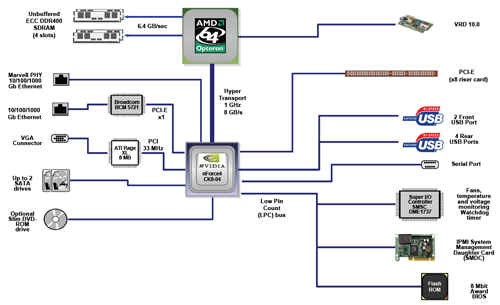AnandTech Exclusive: Sun's sub-$1000 SunFire X2100 Server
by Kristopher Kubicki on September 12, 2005 1:29 AM EST- Posted in
- Systems
The V40z and V20z were innovative in their own rights, but much credit was due to Newisys, the company that designed and built many of the components in those servers. Today, however, the Aquarius (and Galaxy) servers are 100% Sun designed and manufactured. The server takes all of the better computing principles of Opteron, and combines them into a state of the art half depth 1U.
Aquarius is also unique in the fact that the server uses Socket 939 1xx Opterons. These new Socket 939 Opterons have only a single HyperTransport link as opposed to three, which keeps the cost of the chip down. The Socket 939 Opterons also features organic packaging, rather than the traditional ceramic packaging on Socket 940. A peripheral benefit of Socket 939 is that the CPU does not require expensive registered memory; off-the-shelf unbuffered ECC PC-3200 works just fine. The SunFire X2100 actually works just fine without ECC memory either, but with the cost of PC-3200 so cheap these days, why not? The Socket 939 Opterons are a little less picky with the memory configurations; mixing 1GB DIMMs with 512MB DIMMs is perfectly acceptable, but the DIMMs will have to be matched in order for the Opteron to enable dual channel mode.
NVIDIA's nForce4 controller forms the backbone of the Aquarius. There is only a single x8 PCIe lane, and a single HyperTransport lane from the MCP to the Socket. Only two of nForce4's SATA channels are utilized in the X2100, but from what we could tell in the BIOS, all RAID functionality still works. A single PCIe lane is dedicated to the Broadcom BCM 5721 controller giving the system two dedicated Gigabit Ethernet controllers (the other Gigabit Ethernet is located on the nForce4 chip).
Sun's attention to detail scored a lot of points in previous analyses, particularly with regard to system management. The SunFire's X2100 system processor - a QLogic Zircon - sits on a dedicated System Management Daughter Card (SMDC). Initial samples of the Aquarius did not have SMDC boards installed on them, but we lucked out and received one of the first samples in the US with the controller.
In true Sun fashion, the SunFire X2100 is hardly a quiet device. We measured the device in excess of 60dBA from twelve inches away during heavy operation, but since the majority of the X2100's life will be spent in a server room, that's not a problem. On the other hand, the Opteron 175 stayed under 50 degrees Celsius during normal operation according to our SMDC.

Aquarius is also unique in the fact that the server uses Socket 939 1xx Opterons. These new Socket 939 Opterons have only a single HyperTransport link as opposed to three, which keeps the cost of the chip down. The Socket 939 Opterons also features organic packaging, rather than the traditional ceramic packaging on Socket 940. A peripheral benefit of Socket 939 is that the CPU does not require expensive registered memory; off-the-shelf unbuffered ECC PC-3200 works just fine. The SunFire X2100 actually works just fine without ECC memory either, but with the cost of PC-3200 so cheap these days, why not? The Socket 939 Opterons are a little less picky with the memory configurations; mixing 1GB DIMMs with 512MB DIMMs is perfectly acceptable, but the DIMMs will have to be matched in order for the Opteron to enable dual channel mode.
NVIDIA's nForce4 controller forms the backbone of the Aquarius. There is only a single x8 PCIe lane, and a single HyperTransport lane from the MCP to the Socket. Only two of nForce4's SATA channels are utilized in the X2100, but from what we could tell in the BIOS, all RAID functionality still works. A single PCIe lane is dedicated to the Broadcom BCM 5721 controller giving the system two dedicated Gigabit Ethernet controllers (the other Gigabit Ethernet is located on the nForce4 chip).

Sun's attention to detail scored a lot of points in previous analyses, particularly with regard to system management. The SunFire's X2100 system processor - a QLogic Zircon - sits on a dedicated System Management Daughter Card (SMDC). Initial samples of the Aquarius did not have SMDC boards installed on them, but we lucked out and received one of the first samples in the US with the controller.

- Power Up, Power Down
- System Reset
- System Power Cycle
- System NMI
- Request Message Redirection
In true Sun fashion, the SunFire X2100 is hardly a quiet device. We measured the device in excess of 60dBA from twelve inches away during heavy operation, but since the majority of the X2100's life will be spent in a server room, that's not a problem. On the other hand, the Opteron 175 stayed under 50 degrees Celsius during normal operation according to our SMDC.










24 Comments
View All Comments
erikpurne - Monday, September 12, 2005 - link
"...seem too phased by this either;..."Brian23 - Monday, September 12, 2005 - link
Time to buy SUNW stock!TwistyKat - Monday, September 12, 2005 - link
I'd wait to see what happens after the Niagra launch. If that gains traction, the sky is the limit with SUNW.cHodAXUK - Monday, September 12, 2005 - link
Yep, Sun are starting to looking very interesting these days.